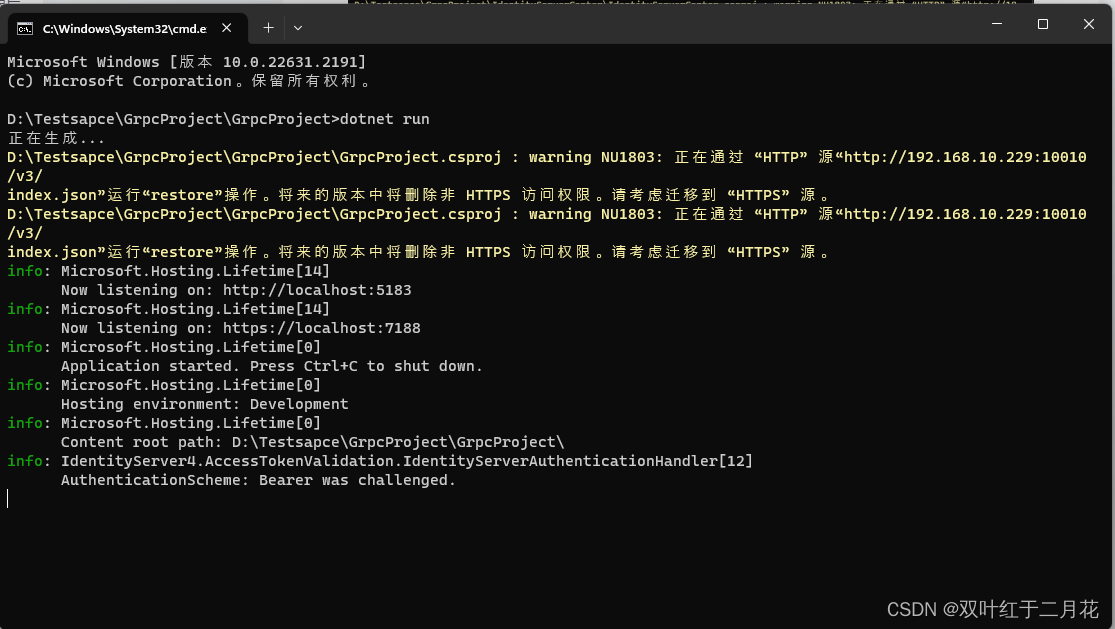一、鉴权和授权(grpc专栏结束后会开启鉴权授权专栏欢迎大家关注)
- 权限认证这里使用IdentityServer4配合JWT进行认证
- 通过AddAuthentication和AddAuthorization方法进行鉴权授权注入;通过UseAuthentication和UseAuthorization启用鉴权授权
- 增加授权策略处理
- 使用密码模式,及简易内存处理
- 生成token带入grpc的metadata进行传递
- 服务端对应的方法标记特性[Authorize]进行验证
- 代码中会有对应的注释说明,如果对您有用,可静下心来细致的浏览
二、实战案例
- 需要一个授权中心服务
- 需要一个gRPC后端服务
- 需要一个客户端调用对应的授权中心和gRPC后端服务
第一步:授权中心
1)引入IdentityServer4包
2)添加IdentityServer注入及启用IdentityServer
// 添加IdentityServer4注入
// 注入id4服务 配置开发证书 配置内存客户端client
builder.Services.AddIdentityServer()
.AddDeveloperSigningCredential()
.AddInMemoryClients(PasswordInfoConfig.GetClients())
.AddInMemoryApiResources(PasswordInfoConfig.GetApiResources())
.AddInMemoryApiScopes(PasswordInfoConfig.GetApiScopes())
.AddTestUsers(PasswordInfoConfig.GetUsers());
// 启用IdentityServer 同时启用认证和授权
app.UseIdentityServer();
app.UseAuthentication();
app.UseAuthorization();
3)密码 在程序中进行了初始化;因为是模拟,这里就没有放到数据库
public class PasswordInfoConfig
{
/// <summary>
/// 获取设定客户端
/// </summary>
/// <returns></returns>
public static IEnumerable<Client> GetClients()
{
return new[] {
new Client{
ClientId="laoliu",
ClientSecrets= new []{ new Secret("laoliu123456".Sha256()) },
AllowedGrantTypes = GrantTypes.ResourceOwnerPassword,
AllowedScopes = new[] {"TestApi","UserApi"},
Claims = new List<ClientClaim>(){
new ClientClaim(JwtClaimTypes.Role,"Admin"),
new ClientClaim(JwtClaimTypes.NickName,"王先生"),
new ClientClaim(JwtClaimTypes.Email,"88@163.com")
}
}
};
}
/// <summary>
/// 获取Api对应的作用域
/// </summary>
/// <returns></returns>
public static IEnumerable<ApiScope> GetApiScopes()
{
return new[] { new ApiScope("UserApi", "用户作用域"), new ApiScope("TestApi", "测试作用域") };
}
/// <summary>
/// 获取Api资源
/// </summary>
/// <returns></returns>
public static IEnumerable<ApiResource> GetApiResources()
{
return new[]
{
new ApiResource("TestApi","测试的API",new List<string>{ IdentityModel.JwtClaimTypes.Role,"email"})
{
Scopes = new List<string> { "TestApi" }
},
new ApiResource("UserApi","用户的API",new List<string>{ JwtClaimTypes.NickName,"email"})
{
Scopes= new List<string> { "UserApi" }
}
};
}
public static List<TestUser> GetUsers()
{
return new List<TestUser>
{
new TestUser()
{
Username="admin",
Password="password",
SubjectId="0",
Claims= new List<Claim>(){
new Claim(JwtClaimTypes.Role,"Admin"),
new Claim(JwtClaimTypes.NickName,"陈先生"),
new Claim(JwtClaimTypes.Email,"77.com")
}
}
};
}
}第二步:gRPC后端服务
1)引入IdentityServer4、IdentityServer4.AccessTokenValidation、Microsoft.AspNetCore.Authentication.JwtBearer包
2)添加IdentityServer权限解析认证
3)启用鉴权和授权
4)对应的类或方法中标记 [Authorize]
4)GRPC的服务及Proto文件这里不贴上来了 有需要可以直接百度云盘下载源码查看
// 注入
builder.Services.AddAuthentication(JwtBearerDefaults.AuthenticationScheme)
.AddIdentityServerAuthentication(options =>
{
// 权限中心 服务地址
options.Authority = "http://localhost:5172";
options.ApiName = "TestApi";
options.RequireHttpsMetadata = false;
});
builder.Services.AddAuthorization();
builder.Services.AddGrpc();
// 启用
app.UseAuthentication();
app.UseAuthorization();
// 字段
app.MapGrpcService<ProtoFieldService>();
// 基础配置
[Authorize]
public override async Task<Empty> BaseConfigService(BaseConfig request, ServerCallContext context)
{
await Console.Out.WriteLineAsync("\r\n--------------------------基础配置--------------------------\r\n");
// 打印字段信息
var properties = request.GetType().GetProperties();
foreach (var property in properties)
{
var value = property.GetValue(request);
await Console.Out.WriteLineAsync($"{property.Name}:{value}");
}
return new Empty();
}
第三步:WPF客户端
1)调用鉴权中心获取token
2)gRPC工厂中配置token传递 或者在调用对应的客户端函数中对metadata传参
3)调用
public class WpfAuthClient
{
private static string _token = null;
public static async Task<string> GetToken()
{
if (_token != null)
{
return _token;
}
var client = new HttpClient();
PasswordTokenRequest tokenRequest = new PasswordTokenRequest();
tokenRequest.Address = "http://localhost:5172/connect/token";
tokenRequest.GrantType = GrantType.ResourceOwnerPassword;
tokenRequest.ClientId = "laoliu";
tokenRequest.ClientSecret = "laoliu123456";
tokenRequest.Scope = "TestApi";
tokenRequest.UserName = "admin";
tokenRequest.Password = "password";
var tokenResponse = await client.RequestPasswordTokenAsync(tokenRequest);
var token = tokenResponse.AccessToken;
var tokenType = tokenResponse.TokenType;
_token = $"{tokenType} {token}";
return _token;
}
} public static class GrpcClient
{
/// <summary>
/// rpc 工厂注入
/// </summary>
/// <param name="services"></param>
/// <returns></returns>
public static IServiceCollection AddWPFGrpc(this IServiceCollection services)
{
if (services == null)
{
throw new ArgumentNullException(nameof(services));
}
services.AddGrpcClient<FieldRpc.FieldRpcClient>(options =>
{
options.Address = new Uri("https://localhost:7188");
}).AddCallCredentials(async (context, metadata) =>
{
var token = await WpfAuthClient.GetToken();
metadata.Add("Authorization", token);
});
return services;
}
}三、执行效果展示
1)启动鉴权中心

2) 启动gRPC后端服务

3)先看下不传token的结果

4)加入token获取传递展示
授权中心返回

gRPC服务展示

客户端返回成功

四、源码地址
链接:https://pan.baidu.com/s/1viu-REcR-ySdR0FE05sohg
提取码:y0m4
下一篇![]() https://blog.csdn.net/qq_31975127/article/details/132446555
https://blog.csdn.net/qq_31975127/article/details/132446555























 3902
3902











 被折叠的 条评论
为什么被折叠?
被折叠的 条评论
为什么被折叠?










